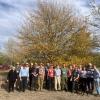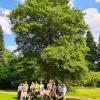Editor's Picks
Plant Focus
Christina Walters, Lisa Hill, Jennifer Crane, Marcin Michalak, Xia Ke, Jeffrey Carstens, Kevin Conrad, Murphy Westwood, Alison Colwell, Joanna Clines, and Pawel Chmielarz
Published May 2016 International Oaks No. 27: 255–266
Abstract
Germplasm banks are increasingly used as an ex-situ conservation strategy. Studies using seeds – the preferred propagules in plant germplasm banks – have revealed the underlying reasons why some cells are able to survive extreme drying and low temperature. This ability is based on the non-lethal conversion of cytoplasm from fluid to solid, as described from materials sciences principles used in studies of thermoplastics and as applied to preserve dry foods and pharmaceuticals. These fluid to solid transitions are called glass formation or vitrification and the reverse process of solid to fluid is called plasticization. Cells of some seeds, such as acorns, do not survive the amount of drying it takes to form a glass at room temperature. To preserve these so-called recalcitrant seeds a combination of cooling and drying under tightly controlled conditions is required and, ultimately, small tissues such as embryos must be stored cryogenically. Feasibility of successful cryogenic treatments will vary among embryos and depend on sensitivity to desiccation, size of cell mass and a host of other factors. We have observed substantial variation in desiccation and freezing tolerance of embryonic cells from diverse oak species. This variation leads us to hypothesize that cryopreservation success is also likely to vary broadly among species or populations. To date, we have achieved high survival following cryogenic exposure of embryonic axes from cold-adapted trees.
Keywords
recalcitrant seeds, orthodox seeds, vitrification, glass formation, longevity
References
Berjak, P., and N.W. Pammenter. 2008. From Avicennia to Zizania: seed recalcitrance in perspective. Annals of Botany 101: 213-228.
Burke, M.J., L.V. Gusta, H.A. Quamme, C.J. Weiser, and P.H. Li. 1976. Freezing and injury in plants. Annual Review of Plant Physiology 27: 507-528.
Cavender-Bares, J. and N.M. Holbrook. 2001. Hydraulic properties and freezing‐induced cavitation in sympatric evergreen and deciduous oaks with contrasting habitats. Plant, Cell & Environment 24:1243-1256.
Chmielarz, P., M. Michalak, M. Pałucka, and U. Wasileńczyk. 2011. Successful cryopreservation of Quercus robur plumules. Plant Cell Reports 30: 1405-1414.
Dickie, J.B. and H.W. Pritchard. 2002. Systematic and evolutionary aspects of desiccation tolerance in seeds. In: M. Black and H.W. Pritchard (eds) Desiccation and survival in plants: drying without dying. Wallingford, UK: CAB International, pp.239-259.
Evenson, R.E., and D. Gollin. 2003. Assessing the impact of the Green Revolution, 1960 to 2000. Science 300: 758-762.
FAO. 2013. Genebank standards for plant genetic resources for food and agriculture. FAO, Rome.
Farnsworth, E. 2000. The ecology and physiology of viviparous and recalcitrant seeds. Annual Review of Ecology and Systematics 31:107-138.
Farrant J.M., N.W. Pammenter, P. Berjak, and C. Walters. 1997. Subcellular organization and metabolic activity during the development of seeds that attain different levels of desiccation tolerance. Seed Science Research 7:135–144.
Guerrant, E.O., K. Havens, and M. Maunder. 2004. Ex situ plant conservation: supporting species survival in the wild (Vol. 3). Washington, D.C.: Island Press.
Joët, T., J.M. Ourcival, and S. Dussert. 2013. Ecological significance of seed desiccation sensitivity in Quercus ilex. Annals of Botany 111: 693-701.
Koehler, K., A. Center, and J. Cavender‐Bares. 2012. Evidence for a freezing tolerance–growth rate trade‐off in the live oaks (Quercus series Virentes) across the tropical–temperate divide. New Phytologist 193: 730-744.
Li, D.Z., and H.W. Pritchard. 2009. The science and economics of ex situ plant conservation. Trends in Plant Science 14: 614-621.
Maschinski, J., and K.E. Haskins (eds). 2012. Plant reintroduction in a changing climate: promises and perils. Washington, D.C.: Island Press.
Meryman H.T. 1974. Freezing injury and its prevention in living cells. Annual Review of Biophysics and Bioengeering 3: 341-363.
Michalak, M., B.P. Plitta, T. Tylkowski, P. Chmielarz and J. Suszka. 2015. Desiccation tolerance and cryopreservation of seeds of black poplar (Populus nigra L.), a disappearing tree species in Europe. European Journal of Forest Research 134: 53-60.
Reed, B.M., V. Sarasan, M. Kane, E. Bunn, and V.C. Pence. 2011. Biodiversity conservation and conservation biotechnology tools. In Vitro Cellular & Developmental Biology-Plant 47: 1-4.
Royal Botanic Gardens Kew. 2016. Seed Information Database (SID). Version 7.1. Available from: http://data.kew.org/sid/ (January 2016).
Soulé, M.E. 1991. Conservation: tactics for a constant crisis. Science 253: 744-750.
Steponkus P.L., M. Uemura, and M.S Webb. 1995. Freeze-induced destabilization of cellular membranes and lipid bilayers. In: Disalvo E.A. and S.A. Simon (eds) Permeability and stability of lipid bilayers. Boca Raton: CRC Press. pp 77–104.
Towill, L.E., P.L. Forsline, C. Walters, J.W. Waddell, and J. Laufmann. 2004. Cryopreservation of Malus germplasm using a winter vegetative bud method: results from 1915 accessions. CryoLetters 25: 323-334.
Vavilov, N.I. (translated by D. Löve). 1992. Origin and Geography of Cultivated Plants. Cambridge UK: Cambridge University Press.
Volk, G.M., C.M. Richards, and P.L. Forsline. 2010. A comprehensive approach toward conserving Malus germplasm. Acta Horticulturae 859: 177-182.
Volk, G.M., C.T. Chao, J.L. Norelli, S.K. Brown, G. Fazio, C. Peace, J. Mcferson, G. Zhong, and P.K. Bretting. 2015. The vulnerability of US apple (Malus) genetic resources. Genetic Resources and Crop Evolution 62: 765-794.
Walters C., and K.L. Koster. 2007. Structural dynamics and desiccation damage in plant reproductive organs. In: Jenks MA, Wood AJ (eds) Plant desiccation tolerance. Iowa: Blackwell Publishing. pp 251–280.
Walters, C. 2015. Orthodoxy, recalcitrance and in-between: describing variation in seed storage characteristics using threshold responses to water loss. Planta 242: 397-406.
Walters, C., G.M. Volk, and C.M. Richards. 2008. Genebanks in the post-genomic age: emerging roles and anticipated uses. Biodiversity 9: 68-71.
Walters, C., D. Ballesteros, and V.A. Vertucci. 2010. Structural mechanics of seed deterioration: Standing the test of time. Plant Science 179: 565-573.
Walters, C., J. Wesley-Smith, J. Crane, L.M. Hill, P. Chmielarz, N.W. Pammenter, and P. Berjak. 2008. Cryopreservation of recalcitrant (ie desiccation-sensitive) seeds. In: Reed, B.M. (eds) Plant cryopreservation: a practical guide (pp. 465-484). New York: Springer.
Walters, C., J.M. Farrant, N.W. Pammenter, and P. Berjak. 2002. Desiccation and damage. In: M. Black and H.W. Pritchard (eds) Desiccation and survival in plants: drying without dying. Wallingford, UK: CAB International, pp.239-259.
Walters, C., P. Berjak, N.W. Pammenter, K. Kennedy, and P. Raven. 2013. Preservation of recalcitrant seeds. Science 339: 915-916.
Wesley-Smith, J., C. Walters, N.W. Pammenter, and P. Berjak. 2015. Why is intracellular ice lethal? A microscopical study showing evidence of programmed cell death in cryo-exposed embryonic axes of recalcitrant seeds of Acer saccharinum. Annals of Botany 115: 991-1000.
Wesley-Smith, J., P. Berjak, N.W. Pammenter, and C. Walters. 2014. Intracellular ice and cell survival in cryo-exposed embryonic axes of recalcitrant seeds of Acer saccharinum: an ultrastructural study of factors affecting cell and ice structures. Annals of Botany 113: 695-709.
Xia, K., M.I. Daws, W. Stuppy, Z.K. Zhou, and H.W. Pritchard. 2012. Rates of water loss and uptake in recalcitrant fruits of Quercus species are determined by pericarp anatomy. PLoS One 7: e47368.
Xia K, M.I. Daws, F.R. Hay, W-Y Chen, Z.K. Zhou, H.W. Pritchard. 2012a. Comparative study of desiccation responses of seeds of Asian evergreen oaks, Quercus subgenus Cyclobalanopsis and Quercus subgenus Quercus. South African Journal of Botany 78: 47-54.
Xia, K., L.M. Hill, D.Z. Li, and C. Walters. 2014. Factors affecting stress tolerance in recalcitrant embryonic axes from seeds of four Quercus (Fagaceae) species native to the USA or China. Annals of Botany 114: 1747-1759.















